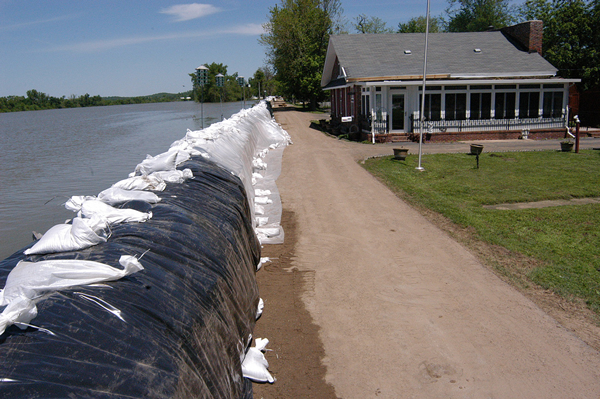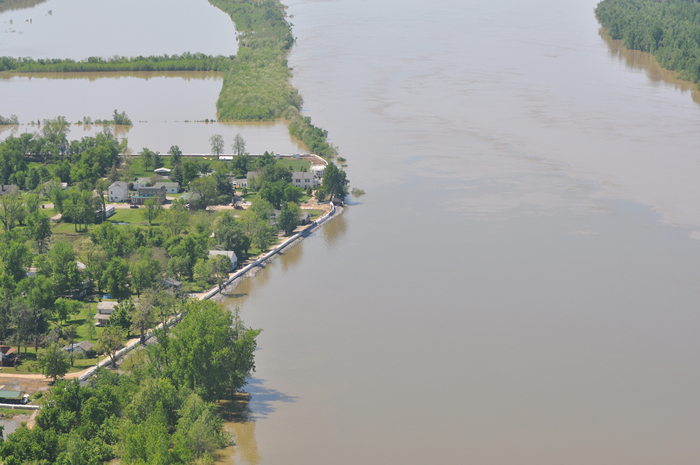
They figured they only had about 75 hours–the amount of time it would take before Ohio River crossed the shoreline and spread through the city of Smithland, Ky.
They are one of the many Louisville District flood fight teams that is responding to regional flooding within the Ohio River basin, flooding that has not been seen for nearly 75 years in some parts of the region.
When the team arrived in Smithland April 21, members immediately began assessing the situation.
“We quickly tried to determine the rate that the river was rising and what level of protection the city had,” said geotechnical engineer Steven Shifflett.
The rains kept coming, and river forecasts got progressively worse. The national weather service was predicting record rainfall. The team concluded that a barrier constructed of regular sandbags couldn’t be set up within 75 hours.
“Based on (calculation) and communication with EOC (Louisville District Emergency Operations Center), we determined that the Typar® geocell wall system was the best choice to stay in front of the rising water,” Shifflett said.
The cells are composed of a durable, nonwoven fabric. The cells come welded together and fit into a 12-foot metal cage frame. The bags are filled and the frame is removed.
The key component, according to Shifflett, is the honeycombed structure of the framed cells that fits together like a puzzle. The interlock of the cells reduces seepage, the movement of water within or through a structure.
The Typar® geocells were recently tested by the U.S. Army Corps of Engineers Research and Development Center at their Coastal and Hydraulic Lab in Vicksburg, Miss. This test, which evaluates a system’s ability to withstand a variety of flood-related conditions, showed that the cells outperformed traditional sandbags in all tests, including time to install, seepage, time to remove, and overall endurance.
As proven as the geocells are, they don’t set themselves up. At Smithland, it took a community effort to get wall built. The district flood fight team, representatives from Typar®, local businesses and citizens all chipped in to set up the 5,000 foot wall before the looming 75-hour deadline.
“Wives and kids began to arrive,” Shifflett recalled. “They were bringing drinks for workers. Everybody was doing their part. It was really a sight to witness to see the community come together, to see how much they accomplished in such a short amount of time. They definitely had a lot of pride in their hometown.”

But the geocell wall hasn’t been the only tool buying more time from Mother Nature. The district’s emergency management team mobilized the delivery of several pumps to Smithland. The pumps move water from ponded interiors areas over the wall and into the Ohio River. While pumps are very effective, Corps lakes play a huge flood reduction role with the Ohio River basin.
The basin covers more than 189,422 square miles, draining streams, rivers, tributaries and snowmelt within 14 states. During periods of heavy rain, surface water runoff is stored in the lakes until swollen streams and rivers below the dams have receded and can handle the release of the stored water. For decades, Corps lakes have saved lives and billions of dollars in property damage.
As of May 5, the lakes and wall is still buying Smithland more time.
“It still may overtop, but it probably would’ve overtopped earlier this week,” said Louisville District Water Management Team Leader Bill Byron.
While water still may exceed the wall’s height and move into Smithland, Corps projects have undoubtedly been pushed to the limit, and they’ve done exactly what they are designed to do. But these rains are historic, said Louisville District Commander Col. Keith Landry.
“You are seeing historical levels of water across Kentucky, but you’re not seeing historic levels of damage due to water,” Landry said. “We are holding it back in flood reduction reservoirs (lakes).”
As a precaution, local officials have evacuated Smithland.
See more photos from the flood fight in Smithland in the Louisville District’s Flickr album: http://www.flickr.com/louisvilleusace
John Neville works is a historian and public affairs employee for the US Army Corps of Engineers, Louisville District. This article has been republished by permission.












